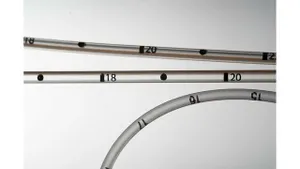After 23 years, it’s time for a NAFTA do-over
“I am positive that a renegotiation or modernization of NAFTA will only bode well for American manufacturing because I have a lot of faith in the U.S. manufacturing industry,” writes Clare Goldsberry.
July 12, 2017

The North American Free Trade Agreement (NAFTA) went into force on January 1, 1994. That week, I happened to be at the massive Consumer Electronics Show (CES) in Las Vegas, and NAFTA was the talk of the floor. It was the beginning of the rush for the border, where large manufacturing corporations had hopes of reducing labor costs while staying close to their largest consumer market—the United States.
Many of the large companies at CES were encouraged by the terms of NAFTA, especially the fact that they could send components over the border to Mexico, where their goods would be assembled, and shipped back into the United States with no tariffs. The age of the maquiladora—twin plant – was at hand, as consumer electronics firms, appliance and automotive OEMs and others set up plants in places such as El Paso, TX, and Ciudad Juarez, Mexico; Laredo, TX, and Nuevo Laredo, Mexico; McAllen, TX, and Reynosa, Mexico; Brownsville, TX and Matamoros, Mexico.
Other maquiladora locations included Nogales, AZ, and Nogales, Mexico; even the small towns of Douglas, AZ, and Agua Prieta, Mexico, shared manufacturing. Larger cities such as San Diego, CA, and Tijuana, Mexico, as well as El Centro, CA and Mexicali, Mexico, became hotbeds for medical device manufacturing, industrial connector and electronics manufacturing. Injection molding companies from the midwestern and eastern United States established manufacturing plants in Arizona to be close to customers in Mexico.
Over the past four decades, first as a sales manager for a mid-sized injection molding and moldmaking company, then as a journalist for plastics industry trade publications and on trade missions with plastics industry groups, I travelled often to Mexico. What I saw on both sides of the border was amazing. Injection molding companies were setting up shop on the U.S. side to provide molded parts for U.S. OEMs who’d moved to Mexico for the cheap—and plentiful as well as skilled—labor. Back then, OEMs almost demanded that their suppliers move to the border. Many molders and a few moldmakers (not many, however) did just that to retain the business.
On the Mexico side, I saw huge manufacturing plants—some of which had been there since the 1960s and 1970s, like Ford Motor Co.—filled with somewhat older equipment and lots of young workers eager to become part of an emerging manufacturing economy. These workers were always friendly, smiling and excited to showcase the facilities buzzing with activity. Over the years the plants in Mexico changed and companies began replacing old molding equipment with new molding presses, some even outfitted with automation. That didn’t take away any jobs—in fact, it created new ones.
I wrote dozens of article about U.S. OEMs and their suppliers heading even further inland to places like Guadalajara that became home to Kodak, Hewlett Packard, Epson Printer, Lexmark Printer, Mattel and many others. By the early 2000s, they were looking at Mexico in the rear-view mirror and heading to China. Many of their molded parts suppliers, however, did not move across the Pacific. It would be another decade before Mexico began to see a manufacturing revival, as many OEMs reshored their manufacturing to Mexico as well as to the United States.
Today, Mexico is enjoying that resurgence, and from what I hear from some of the molders along the border, they’re not too worried about NAFTA in the Trump era. Most of what I read in the business publications and in magazines like MexicoNOW suggests that Mexico isn’t too worried about a “renegotiation” of this 23-year-old agreement. In fact, many say that it needs to be modernized to meet today’s needs.
In a recent article in PlasticsToday, Rosemary Coates, Executive Director of the Reshoring Institute, took a gloomy view, even speculating that NAFTA might be rescinded. I don’t see it that way. Many U.S. OEMs that have put facilities in Mexico over the past two decades still get most of their molds made in the USA because of the continued lack of moldmakers in Mexico.
I’ve heard many molders who export parts and components to customers in Mexico lament the paperwork that is required to get their products through customs. Perhaps that could be made more efficient and simple.
I certainly disagree with Coates’ comment that the prospects of tariffs in a Trump-era trade agreement “only mask the true problem and allow companies to get lazy about becoming cost-efficient and more productive.” Competition has always been good for our economy. We’re still the greatest technological innovators in the world, and our productivity outshines that of many other countries.
Just ask any moldmaker how cheap China molds got them off the dime and into technology, such as high-speed machining, better design software, lights-out machining with the ability to check on the status of unattended machines using iPads or iPhones. I watched this industry turn a 16-to-24-week lead time for molds into eight weeks while maintaining the innovation and quality for which U.S. moldmakers have become known. Innovative mold designs make molding faster, cheaper and of better quality than anything coming from China. The result is that many have won back work they once lost.
I’ve talked to moldmakers who tell me they never thought they’d see the day when unattended machining would be even a remote possibility. The people in plastics processing and moldmaking won’t get lazy by any stretch. And we’ll continue to use automation and robotics to our advantage to beat the competition.
There are many manufacturing jobs still going wanting, and the biggest problem that moldmakers and processors have isn’t just a lack of skilled workers, but a lack of bodies, period! We’re running out of people to do the jobs we need done in this industry, as one molder recently wrote in his weekly newsletter. In that respect, automation will be the savior of manufacturing.
Sure, things change. They always do. But U.S. manufacturers have somehow always managed to meet the challenges by being flexible, moving quickly, following their OEM customers if that’s what they want and being the best they can be in this industry. I am positive that a renegotiation or modernization of NAFTA will only bode well for American manufacturing because I have a lot of faith in the U.S. manufacturing industry.
About the Author(s)
You May Also Like




